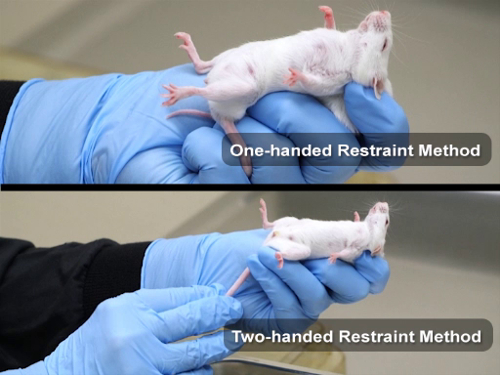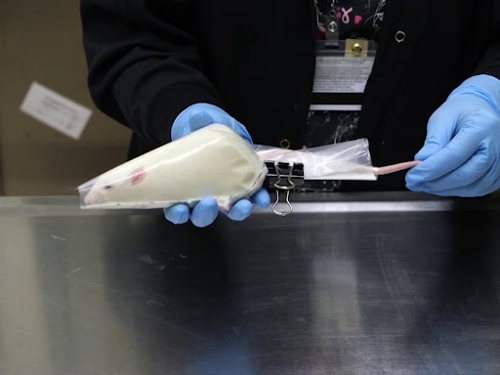啮齿动物的处理和克制技术
Overview
来源: 凯斯图尔特, RVT, RLATG, CMAR;瓦莱丽. 施罗德, RVT, RLATG。圣母大学, #160;
已经证明, 即使是最小的老鼠和老鼠的处理对动物也有压力。处理笼子改变和其他无创程序导致心率、血压和其他生理参数, 如血清皮质酮水平的增加。波动可持续数小时。注射和采血所需的克制方法也会导致可能影响科学数据的生理变化。需要对老鼠和老鼠进行适当的训练, 以尽量减少对动物的影响。 1 小鼠和大鼠可以用约束装置或化学试剂手动约束。本手稿涵盖了手动方法和约束装置的使用。所有的限制方法包括把动物从笼子里抬起来的过程.
Procedure
1. Scruffing
小鼠最常使用 Scruffing 技术进行限制, 但幼鼠也可以用这种方法加以抑制。成年大鼠更难以抑制这种技术, 因为更肌肉颈部, 减少了松散的皮肤数量, 并反感这种方法.
- one-handed 约束方法通常在非常平静的小鼠菌株中使用, 如裸裸、无缺陷和一些宝石菌株。然而, 有更大的风险被咬了这种方法。在尝试 one-handed 方法之前, 新手动物操作人员应该对 two-handed 约束技术感到舒适。
- 将动物放在它们可以抓取的表面上, 如电线条笼顶或垫子.
- 握住 nondominant 手的第三和第四手指之间的尾巴, 并采用柔和的向后牵引。这使动物保持在表面上, 并导致身体被拉长和拉长.
- 转动手, 使手掌朝向动物的身体.
- 用食指和拇指将啮齿动物钉在肩上.
- 轻轻地将拇指和食指向前滑动, 并将其定位在头骨的底部。抓住颈部松弛的皮肤, 抬起动物.
- 使用中指通过将背部皮肤固定在拇
Application and Summary
跳至...
此集合中的视频:

Now Playing
啮齿动物的处理和克制技术
Lab Animal Research
176.0K Views

基本护理程序
Lab Animal Research
28.1K Views

育种和断奶的基本原理
Lab Animal Research
35.9K Views

啮齿动物识别 I
Lab Animal Research
55.1K Views

啮齿动物鉴定 (2)
Lab Animal Research
25.7K Views

药物注射 I
Lab Animal Research
101.4K Views

药物注射 II
Lab Animal Research
35.2K Views

药物注射 III
Lab Animal Research
31.7K Views

药物注射 IV
Lab Animal Research
52.1K Views

血液采集 I
Lab Animal Research
172.8K Views

血液采集 II
Lab Animal Research
74.0K Views

麻醉诱导与维护
Lab Animal Research
51.1K Views

啮齿动物手术的考虑事项
Lab Animal Research
22.6K Views

诊断尸检和组织采集
Lab Animal Research
58.5K Views

无菌组织采集
Lab Animal Research
35.0K Views
版权所属 © 2025 MyJoVE 公司版权所有,本公司不涉及任何医疗业务和医疗服务。





